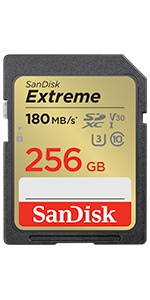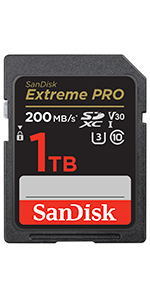SanDisk 128GB Ultra SDXC card up to 140 MB/s with A1 App

SanDisk 128GB Ultra SDXC card up to 140 MB/s with A1 App Performance UHS-I Class 10 U1




Don’t Miss the Moment
SanDisk Ultra SD cards are fast with exceptional video recording performance to let you capture the memories that matter.
Keep Shooting
Delivers plenty of storage so you can shoot tons of photos and hours of Full HD video(3) (1080p) without changing the card.
More Time, More Memories
Save time with ultra-fast speeds to help you quickly move your photos and Full HD videos(3).
Built for Durability
SanDisk Ultra SDHC and SDXC UHS-I cards are durability tested, waterproof, shockproof, x-ray proof, and temperature-proof(4) to help protect your memories from life’s mishaps.
Legal Disclaimers
Not all devices support SDXC memory card formats. Check with your device manufacturer for more details.
(1) Speeds vary by capacity. [256GB-512GB]: Up to 150MB/s read speed engineered with proprietary technology to reach speeds beyond UHS-I 104MB/s, requires compatible devices capable of reaching such speeds. Write speed lower. [64GB-128GB]: Up to 140MB/s read speed engineered with proprietary technology to reach speeds beyond UHS-I 104MB/s, requires compatible devices capable of reaching such speeds. Write speed lower. [32GB]: Up to 120MB/s read speed engineered with proprietary technology to reach speeds beyond UHS-I 104MB/s, requires compatible devices capable of reaching such speeds. Write speed lower. [16GB]: Up to 80MB/s read speed; write speed lower. Based on internal testing; performance may be lower depending on host device, usage conditions, and other factors. 1MB=1,000,000 bytes.
(2) 1GB=1,000,000,000 bytes. Actual user storage less.
(3) Full HD (1920×1080) and 4K UHD (3840×2160) video support may vary based upon host device, file attributes, and other factors. Visit the SanDisk Video Knowledge Base for more information.
(4) Card only. See product packaging and the official SanDisk website for additional information and limitations.
(5) UHS Speed Class 1 (U1) designates a performance option designed to support real time video recording with UHS enabled host devices. See Consumers Speed page on SanDisk site.
(6) Speeds vary by product and capacity. For SanDisk Ultra SD UHS-I Card [256GB-512GB]: Up to 150MB/s read speed engineered with proprietary technology to reach speeds beyond UHS-I 104MB/s, requires compatible devices capable of reaching such speeds. Write speed lower. SanDisk Extreme SD UHS-I Card [256GB-512GB]: Up to 180 MB/s read speed. Engineered with proprietary technology to reach speeds beyond UHS-I 104MB/s, require compatible devices capable of reaching such speeds. Write speed up to 130 MB/s. SanDisk Extreme SD UHS-I Card [128GB]: Up to 180 MB/s read speed. Engineered with proprietary technology to reach speeds beyond UHS-I 104MB/s, require compatible devices capable of reaching such speeds. Write speed up to 90 MB/s. SanDisk Extreme PRO SD UHS-I Card [256GB-1TB]: Up to 200MB/s read speeds, engineered with proprietary technology to reach speeds beyond UHS-I 104MB/s, require compatible devices capable of reaching such speeds. Write speed up to 140MB/s. SanDisk Extreme PRO SD UHS-I Card [64GB-128GB]:Up to 200MB/s read speed. Write speed up to 90MB/s. Based on internal testing; performance may be lower depending on host device, interface, usage conditions and other factors. 1MB=1,000,000 bytes.
SanDisk, the SanDisk logo, SanDisk Extreme, SanDisk Extreme PRO, and SanDisk Ultra are registered marks or marks of Western Digital Corporation or its affiliates in the US and/or other countries. The SDHC and SDXC marks and logos are marks of SD-3C, LLC. All other marks are the property of their respective owners. Product specifications subject to change without notice. Pictures shown may vary from actual products.
2022 Western Digital Corporation or its affiliates. All rights reserved. Western Digital Technologies, Inc. is the seller of record and licensee in the Americas of SanDisk products.
| Weight: | 2.27 g |
| Dimensions: | 3.2 x 2.39 x 0.22 cm; 2.27 Grams |
| Brand: | SanDisk |
| Model: | SDSDUNB-128G-GN6IN |
| Colour: | Black |
| Batteries Included: | No |
| Manufacture: | SanDisk |
| Dimensions: | 3.2 x 2.39 x 0.22 cm; 2.27 Grams |



Sorry dropped it in the camera and it works without issue, I’m finding having multiple cards preferable for photographs rather than an external drive as I’ve lost two in recent years and when it means the loss of a terabyte or two of photos or 5 years of lost photos then I am using memory cards. Ask me in ten years if it was a good idea. Cameras, Nikon P1000, Canon M100, Canon waterproof / shockproof and a Panasonic 280, and cards are interchangeable without issue
Just what I needed for my Camera.. and a great deal due to Black Friday
I always go for Scandisk .. never had a problem with any of their SD cards
Recommend 100%
My wildlife camera would not recognise this card first of all. Went on google and asked questions. Advised to format disk with Rufus. Downloaded the app and worked right away. Excellent SanDisk card.
Not as popular as they used to be of course now full sized SD card but still come in use for some older things – needed one for my car stereo. This is fine, speeds are good and works well. I don’t think it’s as good as general micro sd cards but I would much rather use a straight sd than a micro with a converte
Exactly what I needed for my Wii U – just enough storage as well. Really pleased with this. Paired it with a Beikell Memory Card reader/adapter from Amazon, works as intended.
I don’t need to say much on the brand, I don’t think I’ve ever used any other brand of SD cards, I honestly couldn’t tell you if there even is another manufacturer of SD cards.
They’re reliable, versatile (I’ve used it across many devices), and so simple to use. I got this because of the size, I can get close to 4000 21mp (RAW) photos on it. Which is more than enough, and gives me plenty of confidence that I won’t have to delete photos to take more.
100% would buy again.
very good for normal vidio use but I am getting corruption after reformatting for the 12 time. (card was full each time but the capacity has been reducing after the 8th reformat and getting corrupted files)
Something like a V90 will be better for 4k Video.
If you are just shooting stills on a camera then these are fine.
Never had any issues with Sandisk in the 5 years I have used them.
However, don’t rely on the stated speed. As their fine print says, that is only if you use their proprietary card reader (“proprietary technology”). But my camera will only use the standard UHS-I interface, which has a maximum theoretical speed of 104MB/s (according to their literature). But that is not what you will get. That is only the theoretical top speed of the standard.
Using a little utility called H2TestW.exe to measure my card’s performance on my Windows 10 machine (128GB 140MB/s using a generic USB 3.0 card reader), the read speed I got was 72.8MB/s and, more importantly, the write speed I got was only 30.9MB/s. Not 140MB/s. This is far from the advertised speed, but it is sufficient for my purposes of storage of my photos when I am on holiday, so I am happy with it.
I ran similar tests using my Nikon D610 camera and got similar results. What I did was to place the card in my camera and set the camera to continuous high speed shooting rate, which can do 6 frames per second. I turned image review off so it wouldn’t interfere with the results. I then pressed the shutter release button and started a timer when the green light (card access light) came on. The camera soon filled its internal cache memory and the frame rate dropped to a crawl. I kept the shutter button pressed and kept on timing it. When about 30 seconds had elapsed, I released the shutter release button. When the green light finally went out, indicating all images had been written to the card, I stopped the timer. That took 41 secs. I then connected the card to the computer and there were 50 photos (RAW) with a combined size of 1120 MB. So, doing the maths, 1120 MB / 41 secs = 27.31MB/s.
So that is consistent with the results of the first test. Not the 140MB/s advertised, but to be fair, none of the cards I’ve got do what they advertise. Funny enough, I have another older 128GB Ultra card with an advertised speed of only 80MB/s which actually reads and writes at about 60MB/s! So these older 128GB Ultra cards are significantly faster the their latest versions – almost twice faster!
If you need speed, of all the cards I have, the SanDisk Extreme PRO 64GB 170MB/s cards are the fastest I tested, and they read and write at just over 70MB/s. However, those cards are more expensive. I use them for initially capturing of my images (day shooting) and then transfer them to my bigger, cheaper cards in the evening, when I get back to the hotel room. I then clear those ‘day cards’ for the next day’s shooting. This system works well with my Nikon D610 camera which has dual card slots and allows me to copy the images from one card to another. It also gives me redundancy (copy all images to two separate storage cards) in case of any one card failure.
So the speed of these cards is not as important to me, but I just accidentally discovered these two different ways to measure the speed of cards, and was surprised just how much slower the cards are to the advertised speed, which is all over the front of the cards. Presumably all their competitors are doing similar things.
Overall though, I am happy with SanDisk, so I am happy with my new cards. But one star off for this lack of speed. I hope you found this review helpful.